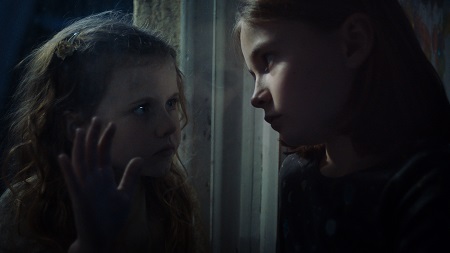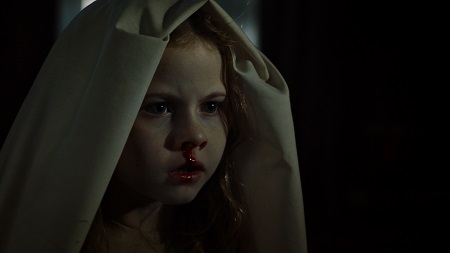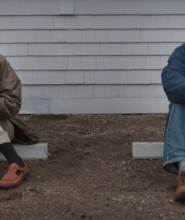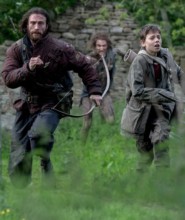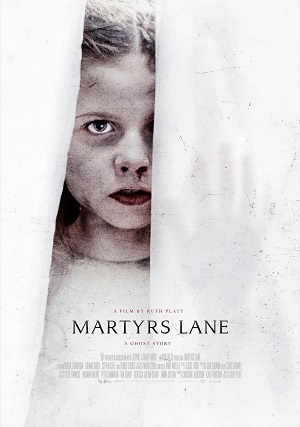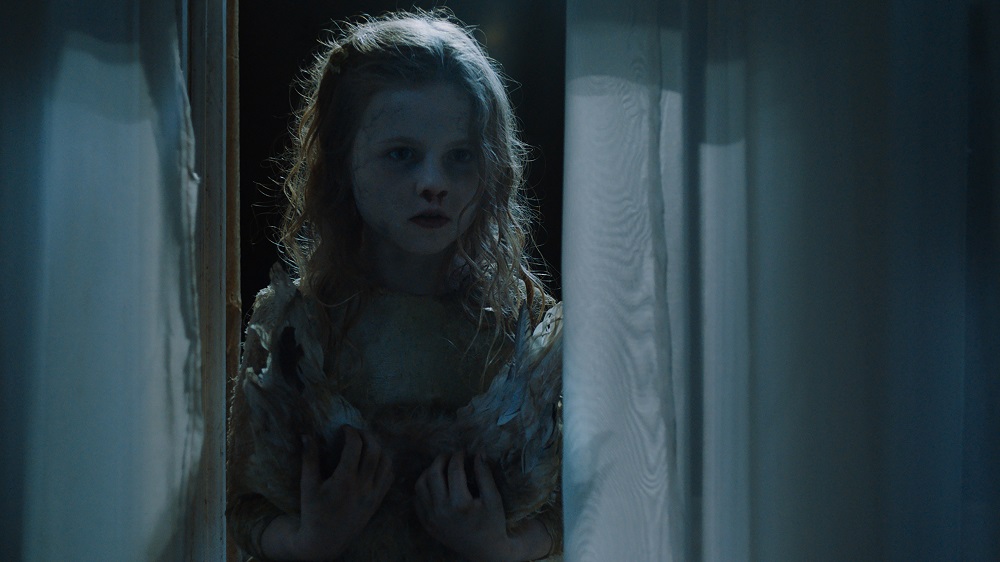
“Martyrs Lane” – Interview with Ruth Platt
by Sara Michelle Fetters - September 17th, 2021 - Film Festivals Interviews
a 2021 Fantasia Film Festival interview
Playfully Terrifying
Ruth Platt’s Martyrs Lane sees emotionally cathartic supernatural horror through the eyes of a child
Martyrs Lane is an emotionally complex thriller revolving around young Leah’s potentially hazardous friendship with another youngster, Rachel, who after a short while Leah can only surmise is a ghost. It is a dual mystery wherein Leah must both discover who this strange visitor who comes to her window each night is, while also figuring out why her own mother is so sad and keeps her mostly at arm’s length.
Writer-director Ruth Platt has created a marvelously powerful supernatural chiller. At various points it reminded me of some sort of eerie combination of Jack Clayton’s The Innocents, Joseph L. Mankiewicz’s The Ghost and Mrs. Muir, Frank LaLoggia’s Lady in White and Guillermo del Toro’s The Devil’s Backbone. Yet Platt also delivers an imaginatively unique tale, one that travels into emotional crooks and crevices that are frequently devastating.
Most of all, the film features performances from child actors Kiera Thompson and Sienna Sayer that easily rank among the year’s best. The duo showcases incredible chemistry, working in such nervily precise tandem that the overall effect they had upon me was almost hypnotic.
I sat down over Zoom to chat with Platt about Martyrs Lane. Some portions of our conversation do tread into spoiler territory. Nothing too serious, but I feel it best to point that out all the same. Here are the edited transcripts:
Sara Michelle Fetters: I have to say, this was a movie where, while I was watching it, I was this giant ball of tension the entire time. I honestly didn’t realize how much I liked it until that ball dissipated into well-earned tears right at the end.
Ruth Platt: That’s very cool. I’m really glad that worked. I hoped for that release at the end, so I’m glad that worked for you.
SMF: This journey that Leah goes on, where did the inspiration for that come from?
RP: I think there are several influences. It’s not an autobiographical story, but there is an autobiographical element, which are my own memories of being a child. My parents were older, and my sisters and brothers were much older than I was, and I was alone quite a lot in this big old house that wasn’t ours but kind of was, in that we lived in it. There was a lot of feeling alone and overhearing stuff. Of wanting to know more and wanting to be involved but not being involved. Your child imagination kind of fills in the dots, especially if you have this vivid imagination, which I did.
That was definitely the catalyst for the story. But then, literature, especially gothic literature, and cinema, that ghost story cinema, much like Guillermo del Toro and the kind of child’s-eye view of life found in The Devil’s Backbone and Pan’s Labyrinth.
There’s also an Alejandro G. Iñárritu film called Biutiful with Javier Bardem. It’s kind of this very socio-realistic story but also has a ghost story element to it which I found interesting. It’s kind of all those elements, I think, combined and filtered through the sound of my brain.
SMF: Were you at all anxious or trepidatious exploring these themes, especially ones relating to grief and loss as seen through a childlike lens?
RP: Yes. I think that was a worry for everybody, actually, while we were in development. Tonally that was something people worried about. You want to protect your child performers and you don’t want to exploit them.
I remember people saying that Linda Blair in The Exorcist was really traumatized, and I think that’s a fantastic movie. I don’t know how much she was traumatized, or if she was traumatized, but you have a responsibility to the child performers to make them feel safe and protected.
What I tried to work on was, rather than kind of delivering the whole story out to them, I was focused on [Kiera Thompson and Sienna Sayer] being in the moment, on that relationship with each other. I wanted them to be these two little kids, to keep them in the now, that spontaneity of thought and playfulness. I did not want to put the pressure of performance on them or the pressure of the whole arc of the story. I tried to keep them in their childhood bubbles, their children bubbles.
But this was definitely something we were very aware of. Even then, some of the stuff they loved doing, like Sienna, who got to wear some nasty makeup… She was just really, really into it. If you keep it playful, they know it’s all make-believe, and children have dark imaginations. As long as you’re respectful and careful with that, I think it’s something you don’t have to be too scared of.
SMF: I think that’s another great thing about the film. You treat the kids respectfully. You let them still be children, especially in the case of Leah. But you don’t spoon-feed things to them. You don’t over-explain or coddle. You let them learn about what’s going on in this world for themselves, which is refreshing. So many of these types of films want to overprotect the viewer because they’re overprotecting the child. Am I onto something there?
RP: I think so. That is the tightrope you’re walking all the time: keeping that sort of respectfulness and being true to that child’s eye, that child’s presence in the film. Keeping that very naturalistic. Not exploitative. Not too genre.
But you also have to allow enough darkness, in the film and in the world, so you’re not coddling or spoon-feeding an emotional narrative, or a safe narrative, or whatever that is, to the adult viewer, and I think we did it. We found it by intuitively working with those children, finding what they’re comfortable with and what makes them tick. What they understand. Keeping them in that moment.
They know it’s make-believe, but even if they were in that environment, in that situation in real life, they would not be privy to too much. You keep them in a situation where they don’t need to know everything. They just need to know what they’re experiencing right at that moment.
SMF: With Rachel, by the nature of who or what she is, she does know more, right? At least, we assume she does.
But even then, there are still pieces missing. This makes for an interesting dual mystery. Leah is not only solving the mystery of why is this relationship so difficult with her mother, but also why this new girl is connected to them.
When you’re manufacturing this puzzle, when you’re putting these pieces together, what was that assembly process like, to make sure all of these disparate, disjointed, angular elements connected so that they completed a finished picture?
RP: That’s interesting, right? For me, the house was like the mother’s brain. Downstairs was kind of her daytime self: very busy, filled with distractions. Nighttime’s sort of subconscious dream state was the upstairs.
In my mind, Leah is almost like a little ghost as well. She’s almost invisible to her mother. And then the actual little ghost, Rachel, is invisible, too, and they both want to be heard.
They both want to be seen. They have different ways of doing that, but I think they’re sort of mirror images of each other. Both are curious, but Rachel is curious about the stuff that she hasn’t experienced. She wants to be let in to experience these things. She craves that living world. For Leah, she craves the love, the cherishing she believes the other one had, maybe still has.
So they’re both fascinated by what the other has, or what they perceive the other one has. They want something from each other. It’s that little exchange of information, and reward and punishment, I guess, that fuels their relationship and makes it interesting.
SMF: How did you find Kiera Thompson and Sienna Sayer? They’re both wonderful. Also, you’re dealing with children who undeniably have a connection, there is chemistry there. I can only assume they must have become great friends while working together. How do you keep that friendship sort of on a razor’s edge so that they’re not too friendly in front of the camera? How do you make sure the tension remains between them when you’re filming?
RP: We saw a lot of children, as many as we could. We started to put them in pairs, and what was interesting about Kiera and Sienna is that we knew they were fantastic, but they were even more fantastic when they were together. They had this chemistry, and it was so palpable from quite early on. We did some screen tests with them in the location, just some improvisations, and you can’t manufacture that kind of chemistry or that kind of energy. It was really interesting.
Also, I wouldn’t say one was more powerful than the other. I think Kiera is very strong. But Sienna, she has this extrovert nature, and Kiera is slightly quieter. And it’s not that Kiera is weaker. She isn’t. There was just this difference in their energy. They complemented each other, like dark and light. That just worked so well.
SMF: It’s interesting you bring that up. There is a forcefulness to Sienna where she is sort of pushing herself into the story, where Rachel is almost forcing her way into Leah’s world.
I don’t want to give anything away, and I don’t want to talk in too great a detail, but there’s a wonderful scene about the two-thirds mark, where Leah finally stands up for herself. Kiera’s performance has been so quiet, so meditative, so thoughtful, that this moment is a big jolt. And it works, mainly because it’s something you would imagine a kid in a similar sort of situation would do.
When you’re dealing with kids and you have moments like this built into your story, do you try to film mostly in sequence? Or, just because of budget limitations and the nature of filming such a technically precise project such as this, was that not possible? How did you navigate these tonal modulations?
RP: That’s definitely what we thought we’d have to do, filming in sequence. But we didn’t have to.
I mean, first of all, we couldn’t: Budgets and just the chaos involved with trying to do that. Child hours on the set. Everything else that happens during a shoot. We couldn’t film in sequence.
But I started to realize Kiera and Sienna didn’t need that because they didn’t need the story arc. What they needed was to be in the moment. They just played off each other so well. There’d be scenes where I would do it line by line: Try it like this. Maybe if you’re thinking like this. Try this with her. What do you want from her there? We played it line by line.
But there were other scenes where I could just film them and they would work it out for themselves. I was just like, I’m not getting involved. It was so truthful and natural. They knew each other so well by that point, and they were great friends with this incredible energy.
Sienna has this quiet bravado, a fantastic kind of mischievousness to her. It was so palpable and was so lovely to see. Kiera is so quiet, so intense. But she can’t be messed around with. It’s a natural thing in her. It is something you can’t manufacture. That was equally lovely.
SMF: What is it about supernatural tales of horror that allow for this freedom to examine grief in a way that is so powerful yet remains so entertaining that you don’t feel like you’re being emotionally smothered in the same way that sometimes happens with a straightforward melodrama?
RP: I can only get back to psychology and nightmares, to Jung. We all have this kind of primal imagination. I assume we all do. I know I do. I’ve always had these vivid nightmares, and they’re very cathartic. I think we need those extremes of emotion to have a symbolic kind of focus. If you nail things down too much and make things very precise and small, make the drama too domesticated, things can kind of lose their wider resonance.
I think through symbolic kinds of imagery, the horror genre is something collective we can all experience. We can put our own life experiences into that viewing experience. I think that’s more collective. We all experience trauma, grief, pain, and loss, all of these things. Through the genre lens, I think we can identify what’s familiar to us and then share it in kind of a collective process. It also allows us to see and accept things that are unfamiliar to us as well. I hope that makes sense.
SMF: What do you hope audiences take away after they’ve watched the film?
RP: I hope they connect to it in some way and that it resonates with them in whatever way that is. I hope they have an emotional experience, one like you described at the beginning, which was really great to hear. An emotional experience that moves and shifts through the piece. I hope it keeps them engaged and I hope it keeps them entertained. I wanted to make something entertaining, but a film that also resonates emotionally.
And I hope it scares you a little bit. [laughs]
– Interview reprinted courtesy of the SGN in Seattle
